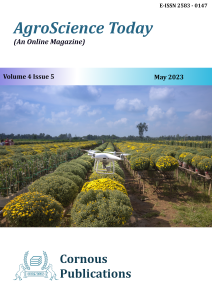The purpose of integrated pest management (IPM) is to reduce the use of chemical pesticides while boosting the use of environmentally friendly farming techniques. Thorough monitoring and decision-making are critical to the effective implementation of IPM, and both can be enhanced by the use of Artificial Intelligence (AI). AI can analyze large amounts of data and make predictions based on historical patterns to help farmers control pests more effectively. In this article, we'll look at how artificial intelligence (AI) is employed in IPM and how it is helpful in adopting ecologically friendly farming practices. One of the most important applications of artificial intelligence (AI) in integrated pest control is pest monitoring and detection. Visible inspections and trapping are two typical but time-consuming ways of pest detection, however they are only based on subjective perceptions. By collecting data on insect numbers and behaviour, the integration of cameras and sensors in AI-based pest monitoring systems enables more precise and rapid identification of infestations. Furthermore, forecasting pest outbreaks and enhancing pest control are two other applications for AI. By analyzing data on insect populations, weather trends, and crop health, AI systems can foresee future pest outbreaks and advise on the most effective treatment techniques. In this context, several Artificial Intelligence (AI) tools offer greater potential than traditional integrated pest control methods, and so have the ability to revolutionize the existing pest management paradigm.
In the recent years, various crop production strategies are adopted for increasing production and productivity of agriculture and horticulture crops. One such concept is the adoption of closer planting density for enhanced utilization of resources thereby reducing the gestation period and increasing the productivity of the crop. Right selection of different components like suitable cultivars-rootstock, canopy management measures, space/land utilization, irrigation mode and scheduling nutrition delivery system, orchard planning and its layout is also very important in this context.
Abandoned, lost or otherwise discarded fishing gears are fishing gears/parts which are lost into water due to various reasons. These lost gears are a global concern to the marine ecosystem as they continue to capturing fishes and other aquatic organisms leading to their mortality known as Ghost fishing. Ghost fishing mostly occurs due to passive gears such as gillnets, trammel nets, lines and traps. As most of the fishing nets are made of synthetic, non- biodegradable materials, nets can remain active in water for several years and continue fishing even when they are lost into seas. From Indian waters also investigation were carried out by ICAR-CIFT regarding fishing gear losses and ALDFG. Those studies points towards the importance of the issue in the country as well as the need for developing mitigation measures to address the harmful impacts of ALDFG.
Malnutrition is a serious global health problem that affects millions of people, particularly in low-income countries. The environment plays a significant role in contributing to malnutrition, as poverty, limited access to clean water and sanitation, and exposure to environmental toxins can all impact nutrient absorption, utilization, and metabolism. Climate change is also a growing concern, as it can affect crop yields, food availability, and the nutritional quality of foods. Addressing the environmental factors that contribute to malnutrition requires a comprehensive approach that considers the social, economic, and environmental determinants of health. This may involve improving access to clean water and sanitation, promoting sustainable agriculture and food production, and reducing exposure to environmental toxins. Additionally, improving access to education and healthcare can also help to prevent and treat malnutrition by increasing knowledge about healthy eating habits and providing medical interventions as needed. Overall, addressing the environmental factors that contribute to malnutrition is essential for promoting optimal health and well-being, particularly in vulnerable populations.
This study provides a brief note on the key elements that causes lowering of honey bee population in the world. Rapid development of cities has caused deforestation, lesser farming and more pollution which directly affects the honey bee communities. The ground reality is that people are not aware of the uses and benefits the bees provide, they are an excellent source of nutrition to all every animals in wild and also in the cities. Planting extra flowering plants will boost the insurgence of honey bee movement in that region which will lead to increased bee population.
As part of the undergraduate course Rural Agricultural Work Experience (RAWE), students involved with farming community on their stay place to experience the agricultural and horticultural conditions in the rural areas. Students conducted demonstartion on zero energy cool chamber, panjakavya, Agri expo, organic food exhibition and tree planting for government school children in orathy. Students also met a farmer Mr. Ramachandran who was involved in the successful organic farming in perennial tree crops at vadamanipakam village. They collected the information about his innovational farming method and discussed with this article.
